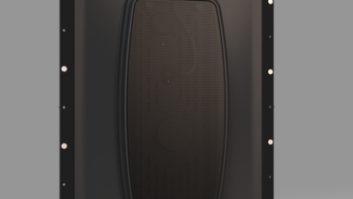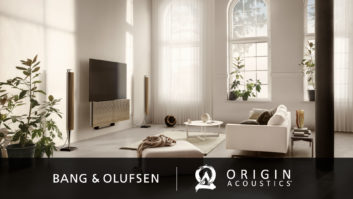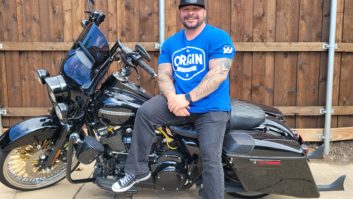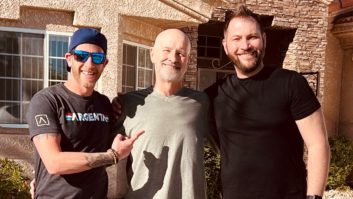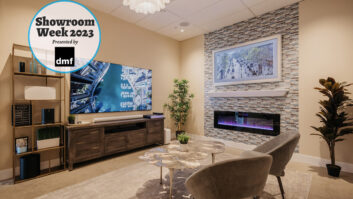It’s been two years since industry icon Jeremy Burkhardt returned to the architectural loudspeaker business with Origin Acoustics. Along with his partners, Ed Haase and Ken Humphreys, Burkhardt launched the brand at CEDIA Expo 2014 with 8-inch speakers that could fit into 6-inch in-wall baffles, and 10-inch speakers that fit into 8-inch baffles, along with other design innovations such as the Zip Clip. At CEDIA 2016, Origin celebrated its two-year anniversary with new partnerships and nearly 40 new products. Residential Systems reached out to Burkhardt to learn more about this news.

Among the speakers that B&O commissioned Origin Acoustics to manufacture for it is the LCR66
At CEDIA, B&O introduced nine architectural speakers that were OEM’d by your company. How did that relationship come about and why was it important for Origin to be involved in such a project?
We started manufacturing B&O speakers 20 years ago while we were also manufacturing speakers for Speakercraft, Sonance, Polk, and JBL. We formed a good partnership based on mutual respect for pushing what was possible in sound quality and aesthetics. In fact, we made a plastic grille back in the early 1990s for them that was the first to allow IR control and featured square holes. We chose to pursue the B&O partnership as we have respected their designs for years, and combining our architectural expertise with their 100-year design/aesthetic heritage has created a combo of industry-changing sound and aesthetics that was just a fantasy a few years ago.
Origin partnered with AudioControl to bake your DSPs into that company’s amplifiers. Why was this an important arrangement for Origin?
AudioControl makes great-sounding amplifiers that are a standard for many of our integrators. Incorporating our DSP settings will allow our architectural speakers to perform better in an installed environment than 99 percent of the cabinet-box speakers on the market that do not use DSP. We have made a huge advancement for what can be achieved in terms of sound quality by working together.

Origin Acoustics CEO Jeremy Burkhardt announced the company’s new partnership with B&O at CEDIA.
In a similar announcement, Origin is now iRoom’s North American distributor. How does that brand fit into your plans?
iRoom makes visually stunning in-wall and tabletop mounting solutions for iPads. With their QuickKey shortcuts, all integrators have easy access to their most commonly used commands in home control. In addition, they were the first to incorporate IP commands into their solutions. Our dealers need products like this that service the luxury market and are protected with select distribution, as opposed to being sold to everyone through third-party distributors. Our select network ensures luxury products are provided to the finest homeowners without compromise.
What was your rationale for so many new products, when the typical in-wall speaker life cycle is more like five years?
I live by the creed that “You Must Obsolete Yourself First.” We have spent close to $10 million on Origin Acoustics, and we have been shipping for a little over 19 months. This investment in product ensures we currently have the easiest-to-install and best-sounding products ever created for the CEDIA integration market. The old days of creating a product and letting it run a several-year course is nothing more than a perpetual laziness by manufacturers led by a goal to save money and recuperate tooling costs on products. This industry was at a peak of innovation when competition was at the highest–when Frank Sterns was running Niles, Scott Struthers running Sonance, and I was at SpeakerCraft. We all made one another better and pushed the boundaries. For the last few years, the architectural speaker industry stagnated. Origin Acoustics’ aggressive spending will cause everyone to step up, start innovating, and making better products.
So, as a final thought, how do you feel about Origin Acoustics two years into your return to the industry?
We are beyond excited about the insanely fast support our integration friends and retailers have given us. We showed up with dozens of new products and said, “Guys you know us, we made you better products, created a killer service model, and gave you higher profits…. please try our new stuff.” And amazingly, they have, and we are selling tens of millions of dollars of speakers. We are just getting started. I screwed up selling SpeakerCraft to corporate America. I want Origin to be the last company I own and operate in this industry. I have no plans of selling it, and as a 44-year-old who has been doing this for 25 years, I can only hope to do it for at least 25 more years with Origin. We are humble and just want to do better and have a platform that will allow us to continue to invest heavily into R&D, so we can make more cool stuff. I live this industry and my best friends are here with me. I don’t have a job; I have a life doing exactly what I love. I think that makes me one of the luckiest people I know, and I am so grateful daily to be able to get up and do what makes me happy.
